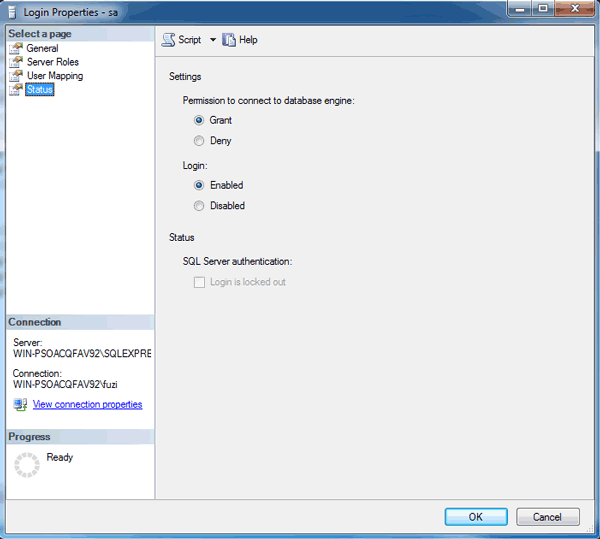
So if your local login has a corresponding login on the linked server, with the same credentials, and it has the appropriate permissions, you’ll be able to connect using your local login. SQL Server uses the credentials of the local login when connecting to the linked server on behalf of the login. When you use sp_addlinkedserver to create a linked server in SQL Server, a default mapping between all logins on the local server and remote logins on the linked server is automatically created. In this article, I aim to provide a high-level overview of how SQL Server maps local logins to remote logins on the linked server. So this would apply to every new named instances that it will be setup to use dynamic ports.When configuring a linked server in SQL Server, setting up the logins can sometimes be confusing.
#Sql server sa account for remote login install
If you install it with a named instance it is setup to dynamic ports. One thing to mention, if you install SQL server with the default instance it is setup with the static port 1433 with tcp/ip disabled. And what’s up with the netstat? It is a completely unesassary step to perform as you the configuration and the dynamic port in sql configuration manager and if it is setup with static or dynamic from the beginning.

If you open for SQL browser as a program in the firewall you don’t need to add udp port. So to me it looks like you are saying that they must open for both and have SQL server browser service running even with static ports, that is not the case. SQL browser is used when dynamic ports are configured for SQL server.

This is simple, if you use static ports you do not use SQL broweser and do not need to open for it in the fierwall. I Think you miss a very big point in this guide that you confuse people and not telling them the different in using dynamic and static port in this context.
#Sql server sa account for remote login how to
You show how to configure SQL aerver to use the standard port 1433. Open SQL Management Studio and right-click server name in the left pane and select Properties

If you want to use GPO to configure SQL server Standard or Enterprise to accept remote connections see my new post: How to use GPO to allow SQL 2012 accept remote connectionsĮnable remote connections on the instance of SQL Server that you want to connect to from a remote computer.ġ.

To configure SQL Server 2012 Express to allow remote connections, you must complete these steps: SQL Server Browser is used by clients transparently and there is no need for special configuration. Sql Server Browser service is required for both TCP and named pipes protocols. The Sql Browser listens on UDP 1434 and answers all client request with the port number the current instance is using. This is the function of the Sql Server Browser Service to inform the clients of the actual port. Named SQL instances listen on dynamic ports. When you try to connect to an instance of Microsoft SQL Server 2012 Express from a remote computer, you might receive an error message.


 0 kommentar(er)
0 kommentar(er)
